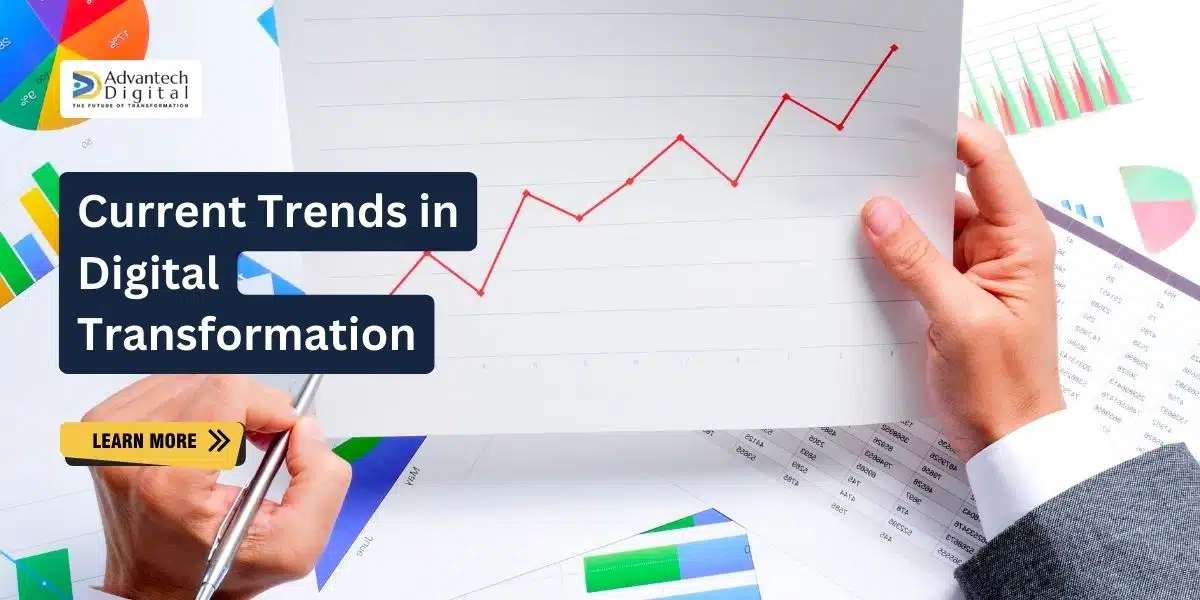The digital transformation current trends revolution is reshaping businesses across industries. Artificial intelligence, cloud computing, and IoT are driving this transformation. Companies must adapt to stay competitive in 2025 and beyond.
Key trends are emerging that will define the future of digital transformation. These trends offer opportunities for innovation, efficiency, and growth. Understanding them is crucial for organizational success.
AI and machine learning are revolutionizing business processes. They automate tasks, enhance decision-making, and personalize customer experiences. Cloud computing provides the foundation for agility and scalability in digital initiatives.
Data analytics unlocks valuable insights for competitive advantage. Cybersecurity protects digital assets from evolving threats. The Internet of Things connects devices, enabling smarter operations.
5G networks are set to transform mobile experiences and enable Industry 4.0. Blockchain technology offers new opportunities for secure and transparent transactions across industries.
Advantech Digital leads the charge in digital transformation solutions. They help businesses embrace AI, optimize processes, and enhance competitiveness. Their holistic approach covers customer experiences and leadership strategies.
Key Takeaways
- AI and machine learning are driving operational efficiency, personalized experiences, and smarter decision-making.
- Cloud computing provides the foundation for agility and scalability in digital transformation initiatives.
- Data analytics is crucial for unlocking insights and gaining a competitive edge.
- Cybersecurity measures are essential to protect digital assets from evolving threats.
- IoT, 5G networks, and blockchain technology are enabling new possibilities for smarter operations and secure transactions.
Artificial Intelligence and Machine Learning: Driving Forces of Digital Transformation
AI and machine learning are revolutionizing digital transformation. These technologies optimize operations, extract valuable insights from data, and enhance customer services. Organizations are leveraging AI to boost efficiency and productivity across various sectors.
By 2028, Gartner predicts 75% of enterprise software engineers will use AI coding assistants. This marks a significant increase from just 10% in 2023. AI’s impact on workflow optimization is becoming increasingly evident.

AI-Powered Workflows for Operational Efficiency
AI excels at streamlining operations by automating tasks and minimizing errors. It optimizes supply chains and enhances overall efficiency. Chatbots and virtual assistants powered by AI handle customer queries with human-like interactions.
AI tools automate routine tasks, allowing employees to focus on higher-value activities. This boost in productivity leads to increased job satisfaction. Accenture reports that 63% of high-growth organizations have embraced flexible work models.
AI-Enhanced Customer Experiences
Delivering exceptional customer experiences is crucial in today’s competitive market. AI empowers businesses to personalize content and interactions based on individual preferences. Organizations can offer targeted recommendations and proactive customer service using AI algorithms.
Siemens’ 2021 ROI of DX survey reveals that customers expect smarter products with better experiences. To meet these expectations, companies must embrace hyper-connected systems, automation, and AI analytics.
Predictive Analytics for Smarter Decision-Making
Predictive analytics, powered by AI and machine learning, enables data-driven decision-making. By analyzing trends and behavior, businesses can generate accurate forecasts and identify emerging market trends. This allows companies to develop effective strategies and stay competitive.
“Organizations are advised to focus on change management first and unify around a shared vision of the future before finding the right solutions for achieving goals.” – HBR-Rehat report
AI integration in decision-making processes helps companies stay ahead in a dynamic business environment. It enables proactive moves and strategic planning based on data-driven insights.
| AI Application | Benefits |
|---|---|
| Chatbots and Virtual Assistants | Provide human-like interactions and handle customer queries efficiently |
| Personalized Content | Tailor content and interactions to individual preferences and needs |
| Predictive Analytics | Enable data-driven decision-making and accurate forecasting |
Cloud Computing: Enabling Agility and Scalability
Cloud computing has revolutionized business operations, offering unprecedented agility and scalability. It allows organizations to adapt swiftly to market demands and provision resources on-demand. The flexibility of cloud models like Software as a Service (SaaS), Platform as a Service (PaaS), and Infrastructure as a Service (IaaS) has transformed business practices.
Cloud computing has reshaped IT departments into strategic enablers. They can now respond quickly to changing business needs. 72% to 88% of businesses report improved agility and scalability from cloud investments.

The fusion of cloud computing and artificial intelligence (AI) has sparked an AI revolution. AI utilizes vast amounts of cloud-stored data for predictive analysis. This powerful combination has created new opportunities across various industries.
“Cloud computing is not just about cost savings; it’s about unleashing the full potential of digital transformation and driving business growth.”
Cloud computing is transforming industries from manufacturing to retail, healthcare to education. Manufacturing reduces downtime and costs while enhancing efficiency. Retailers use cloud-powered analytics to predict trends and provide personalized shopping experiences.
Cloud computing’s versatility caters to diverse organizational needs. Private clouds offer dedicated infrastructure for strict data privacy requirements. Hybrid clouds combine private and public resources, balancing data sensitivity with scalability and cost-efficiency.
As we move into the digital future, cloud computing will drive innovation and scalability. It enables businesses to unlock new opportunities and streamline operations. Cloud computing is the key to success in our increasingly competitive landscape.
Data Analytics: Unlocking Insights for Competitive Advantage
Data analytics has become crucial for organizations seeking a competitive edge. It leverages big data and real-time analytics to unlock valuable insights. Companies can drive data-driven decision-making and business intelligence through this powerful tool.

Businesses use data analytics to identify patterns in vast amounts of information. This empowers leaders to extract actionable insights and make informed decisions. Organizations can optimize operations, personalize customer experiences, and discover new growth opportunities.
Big Data and Real-Time Analytics
The big data era has arrived, offering businesses a competitive advantage. Organizations use various tools to decipher complex datasets from multiple sources. These tools employ advanced machine learning and AI algorithms to uncover hidden patterns.
Real-time analytics provides instant insights into business operations. It processes data as it’s generated, enabling swift decisions based on current information. This allows companies to respond quickly to market changes and emerging trends.
Data-Driven Decision Making
Data-driven decision-making is revolutionizing business operations. It helps organizations reduce risk, improve stability, and adapt to industry trends. This approach enables informed strategic planning and enhanced customer satisfaction.
| Data Analytics Technique | Description |
|---|---|
| Predictive Analytics | Utilizes historical data to predict future events |
| Data Mining | Extracts patterns from large data sets |
| Data Integration | Consolidates data from diverse sources into a coherent framework |
| Data Preparation | Cleans and formats data to ensure accuracy and consistency |
To leverage data analytics, organizations must foster a data-driven culture. Investment in infrastructure and providing easy access to data are essential steps. Empowering employees to analyze and apply data in their jobs is crucial.
Data analytics can help companies identify patterns and trends in large volumes of data, enabling leaders to extract actionable insights.
Embracing data analytics can unlock a wealth of insights for businesses. It drives competitive advantage by optimizing processes and enhancing customer experiences. Data-driven decision-making is key to success in the digital age.
Cybersecurity: Protecting Digital Assets in the Age of Transformation
Cybersecurity is crucial as organizations adopt cloud computing, IoT, AI, and big data. Cyberattacks are becoming more frequent, complex, and impactful. Protecting digital assets is essential to prevent financial losses, reputational damage, and operational disruptions.
Cyber-attacks now occur every few seconds, targeting businesses of all sizes. Almost half of all attacks aim at smaller organizations. Nearly half of ransomware attacks target backup systems to force ransom payments.
Phishing attacks have evolved beyond simple spam emails. Cybercriminals craft convincing messages impersonating trusted sources. Cloud computing introduces new challenges, with simple configuration mistakes potentially exposing data.
Advanced Threat Detection and Response
Businesses must employ advanced threat detection and response mechanisms. Key protective measures include:
- Multi-factor authentication (MFA)
- Regular software updates and patch management
- Advanced threat detection systems powered by AI and machine learning
- Comprehensive incident response plans
Outsourced cybersecurity services are crucial in defending against cyber risks during digital transformation. These services focus on threat identification, risk assessment, and incident response. Increased collaboration and information sharing among stakeholders are essential for effective threat combat.
Cybersecurity Awareness and Training
Cybersecurity awareness and training programs are vital. They educate employees on best practices to prevent data breaches and safeguard sensitive information. Consider these eye-opening statistics:
| Threat Type | Potential Impact |
|---|---|
| Ransomware attacks | Costly downtime, recovery efforts, disruption of critical services |
| Phishing attacks | Significant financial losses, data breaches |
| Insider threats | Data security risks, financial loss, regulatory action |
| DDoS attacks | Substantial business losses, difficult to stop |
Implementing security measures like Zero Trust Security is essential to address evolving cybersecurity threats. Organizations can protect their digital assets by prioritizing cybersecurity, data privacy, advanced threat detection, incident response, and cybersecurity awareness.
Internet of Things (IoT): Connecting Devices for Smarter Operations
The Internet of Things (IoT) is revolutionizing business operations by connecting devices and enabling smarter processes. IoT’s potential economic value could reach $12.5 trillion globally by 2030. Companies across industries are eager to adopt this transformative technology.
IoT devices and smart sensors facilitate remote monitoring, predictive maintenance, and process optimization. Real-time data collection and analysis allow businesses to make informed decisions and respond quickly to issues. IoT applications in factories alone could generate up to $3.3 trillion by 2030.

IoT integration with AI and cloud computing creates powerful solutions for manufacturing, healthcare, and logistics. The Industrial Internet of Things (IIoT) reduces downtime, enables new business models, and enhances customer experiences. By 2024, cellular IoT connections are projected to reach 3 billion.
| IoT Use Case | Share of Economic Value |
|---|---|
| Optimizing Operations | 41% |
| Healthcare Applications | 15% |
| Human Productivity | 15% |
| Condition-Based Maintenance | 12% |
With 41.8 billion active IoT-connected devices worldwide as of March 2023, robust cybersecurity is crucial. CEOs must prioritize cybersecurity in product lifecycles and establish post-breach response plans. This ensures the safety and integrity of IoT systems.
The deployment of 5G networks in 2024 is poised to revolutionize IoT connectivity, enhancing efficiency and reliability, particularly in sectors like smart cities and industrial IoT.
The future of IoT lies in its integration with 5G networks, edge computing, and AI. This combination will enhance IoT capabilities across various sectors. As businesses embrace IoT, we’ll see increased efficiency, improved customer experiences, and innovative industry solutions.
5G Networks: Enabling the Next Generation of Digital Transformation
5G networks are revolutionizing the digital landscape, offering unprecedented opportunities across industries. This ultra-fast connectivity transforms our lives, work, and interactions. The impact spans from enhanced mobile experiences to the rise of Industry 4.0 and smart factories.

5G technology delivers speeds up to 100 times faster than 4G networks. It boasts significantly lower latency and real-time data exchange. These features are vital for industries like manufacturing, energy, and transportation.
By 2030, 5G technology implementation is projected to add $960 billion to global GDP. This represents a 0.7% increase in overall economic value.
Enhanced Mobile Experiences
5G networks significantly improve mobile experiences. Users can enjoy seamless streaming, immersive augmented reality, and real-time interactions. Near-instantaneous response times enable uninterrupted, high-quality experiences on mobile devices.
“5G is anticipated to lead to the creation of 5.5G, offering a tenfold increase in network performance compared to 5G, reaching peak rates of 10 Gbit/s for mobile and home broadband users.”
Enabling Industry 4.0
5G networks are crucial in enabling Industry 4.0 and the rise of smart factories. They connect IoT devices and enable real-time data processing at the edge. This empowers industries to achieve unprecedented levels of automation, efficiency, and innovation.
Over 20,000 5G use cases are already operational across 50% of the top 97 industries. These include mining, steel, chemicals, power grid, manufacturing, and cement.
| Industry | 5G Use Cases | Benefits |
|---|---|---|
| Manufacturing | Remote monitoring and control | Increased efficiency and reduced downtime |
| Energy | Smart grid management | Optimized energy distribution and reduced waste |
| Transportation | Autonomous vehicles and traffic management | Enhanced safety and reduced congestion |
5G-Advanced is expected to improve enterprise deployment by enhancing speed, coverage, mobility, and power efficiency. Passive IoT technology could increase connected devices from 10 billion to 100 billion. This may result in a tenfold reduction in CO2 emissions transmitted via mobile networks.
Embracing 5G-powered digital transformation requires addressing key challenges. These include infrastructure deployment, spectrum availability, security concerns, and interoperability issues. Overcoming these hurdles will unlock 5G’s full potential, ushering in a new era of innovation.
Explore our extensive resources and insights to find out more about the 5G network-enabled future of digital transformation.
Digital Transformation Current Trends
Agile methodologies and DevOps practices drive success in digital transformation. These approaches help businesses adapt swiftly to market changes and deliver value efficiently. Gartner predicts hyper-automation strategies can cut operational costs by 30% by 2024.
The hyper-automation software market is projected to reach $860 billion by 2025. This trend highlights the growing importance of automation in digital transformation efforts.

A customer-centric approach is crucial for successful digital initiatives. Customer Data Platforms (CDP) enable personalized marketing campaigns. McKinsey reports significant changes in consumer behavior during the pandemic.
Three out of four Americans tried new shopping behaviors. There’s a lasting shift towards online grocery shopping and home cooking. These trends underscore the need for businesses to adapt their strategies.
Fostering a digital culture and effective change management are vital for digital transformation. Aligning technology investments with business goals is essential. Cultivating continuous improvement helps companies stay competitive.
RAM’s successful digital transformation story serves as an inspiring industry example. It demonstrates the potential benefits of embracing digital change.
| Trend | Impact |
|---|---|
| Hyper-automation | 30% reduction in operational costs by 2024 |
| Composable Enterprise | 80% faster development of new features |
| Hybrid Work Model | 54% of workers prefer a hybrid work model |
| Buy Now, Pay Later (BNPL) | Global BNPL market to reach $576 billion by 2024 |
Staying informed about digital transformation trends is crucial for business success. Embracing agile methodologies, DevOps practices, and customer-centric approaches is key. Organizations can thrive by implementing the right strategies and fostering a digital culture.
Blockchain Technology: Revolutionizing Trust and Transparency
Blockchain technology is transforming business operations, bringing unparalleled trust and transparency to various industries. This decentralized, immutable ledger ensures data integrity and security. It enables seamless collaboration among parties, streamlining processes and reducing costs.
Blockchain’s potential to enhance efficiency makes it a game-changer in digital transformation. Its impact spans across multiple sectors, promising to revolutionize how we conduct business and share information.
Empowering Supply Chain Management
Blockchain technology shines in supply chain management. It enables end-to-end traceability, reducing counterfeiting risks and boosting efficiency. Walmart’s blockchain solution improved mango traceability in the U.S. dramatically.
The system cut tracing time from seven days to 2.2 seconds. This level of transparency prevents fraud and ensures compliance with quality standards throughout the supply chain.
| Industry | Blockchain Application | Benefits |
|---|---|---|
| Pharmaceuticals | Mediledger platform | Data integrity, confidentiality, and traceability |
| Music | Smart contract-based royalty payments | Automation, cost reduction, and increased trust |
| Finance | Streamlined auditing processes | Reduced time and cost, enhanced reliability |
| Healthcare | Secure medical record management | Data security, privacy, and interoperability |
Enabling Secure Data Sharing
Blockchain facilitates secure data sharing, ensuring integrity and privacy. Smart contracts automate transactions and streamline processes, reducing costs and increasing speed. Trust is crucial in today’s digital landscape.
A PwC study shows that 71% of consumers are unlikely to buy if they don’t trust a company with their data. This underscores the importance of blockchain’s secure data-sharing capabilities.
Imogen Heap’s partnership with Ujo Music developed a smart contract-based system for transparent royalty payments to artists in the music industry, showcasing the potential of blockchain in enabling fair and efficient compensation.
The blockchain market is projected to generate over $94 billion in revenue by 2027. This growth indicates blockchain’s staying power and future impact. It’s set to play a pivotal role in shaping digital transformation.
By revolutionizing trust and transparency across industries, blockchain is paving the way for a more secure and efficient future. Its potential applications are vast and continue to expand.
Conclusion
The digital transformation landscape is evolving rapidly as we approach 2025. Businesses can gain a competitive edge by embracing AI, machine learning, cloud computing, and data analytics. These technologies, along with IoT, 5G networks, and blockchain, drive innovation across various sectors.
Online retailers like Amazon and Alibaba use AI and analytics for personalized shopping experiences. Traditional retailers are investing in digital tech to enhance customer interactions and streamline operations. However, managing sensitive data while ensuring compliance and security remains challenging.
Manufacturing businesses are transforming through Industry 4.0 technologies, including robotics and 3D printing. Service-based companies leverage data and AI to predict customer behavior and offer personalized experiences at scale. Emerging business models enable tailored offerings and optimized pricing strategies.
Businesses must navigate privacy concerns, cybercrime impact, and technology skills shortages. Leaders need to balance growth, innovation, and ethical responsibilities. Partnering with experts like Advantech Digital can help companies unlock these technologies’ full potential.
Success in 2025 and beyond requires fostering customer-centricity, investing in upskilling, and staying attuned to the digital landscape. By embracing these strategies, businesses can position themselves for long-term growth and innovation.






